The
Proton launch vehicle,
developed in 1965, allowed the Soviet scientists to quadruple the size of their planetary probes.
With these large spacecraft, the early 1970s became a golden age of planetary exploration.
Soviet robots roamed the Moon, and six missions to Mars included the first landing.
However, Venus remained the primary focus of Soviet planetary exploration, continuing with a radically new generation of descent vehicles.
The Second-Generation Luna Probes and Mars-69The second-generate planetary probes were influenced by designs of earlier spacecrafts. |
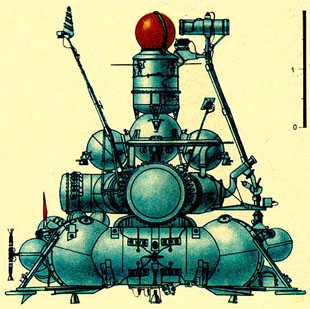 Luna-16
Luna-16
|
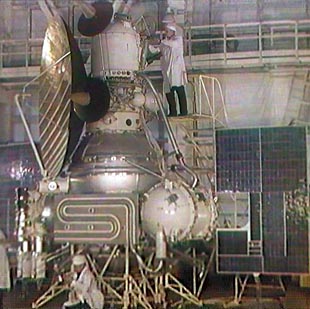 Mars Orbiter, M-69
Mars Orbiter, M-69
|
|
Babakin and his deputy O.G. Ivanovskii designed a standardized Lunar spacecraft for a series of ambitious missions. Sharing a common landing craft, Luna-16 and 20 returned Moon rocks to Earth, Luna-17 and 21 carried the large Lunokhod rovers, Luna-19 and 22 were heavy orbiters, and Luna-24 carried a drilling apparatus that returned a 1.6 meter deep core sample of the Lunar crust.
Project M-69 was a pair of Mars orbiters, unfortunately destroyed by launch mishaps. Its design was influenced by the Lunar spacecraft, as were the 1988 Fobos orbiters. The Second-Generation Mars/Venus SpacecraftFor the 1971 Mars launch, a radically redesigned spacecraft became the standard for subsequent missions to Mars, Venus and orbiting space telescopes. This design was carried out by Babakin, and his deputy V.G. Perminov. Perminov credits V.A. Asyushkin with designing the basic structure of the new Mars/Venus vehicle. |
 Mars-3
Mars-3
|
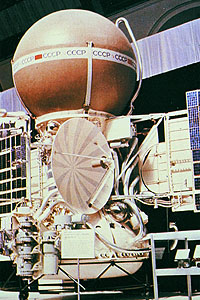 Venera-13
Venera-13
|
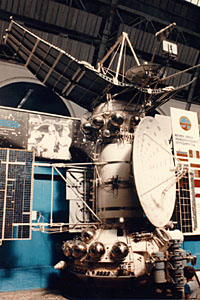 Venera-15
Venera-15
|
|
Seen above, a common spacecraft bus could be fitted with a variety of mission-specific modules: Mars descent vehicle, Venus descent vehicle, and an orbital synthetic-aperture radar mapper. In addition, a Mars orbital instrument package and the Earth-orbiting Astron space telescope used this bus.
The multipurpose vehicle was first used on six Mars missions in 1971 and 1973, and then ten
Venus missions from 1975 to 1984.
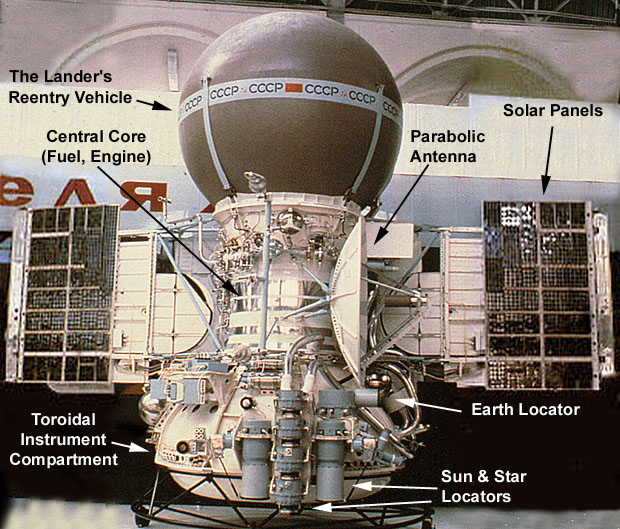
The Venera Spacecraft Telemetry was sent to Earth with a parabolic high-gain antenna, using the decimeter or centimeter bands. Telecommands were received on 770 MHz by helical semi-directional antennas, which could also be used to send telemetry at low bit rates in an emergency. Meter-band helical antennas were located on the back of the solar panels for communication with the landing module. By this time, the second-generation Saturn telemetry systems were in use, based entirely on phase modulated PCM. The telemetry from Venus was sent at 3072 coded bits/second, using a K(6, 1/2) convolution code. A new orientation control system was based on M-69's design. The external astronavigational sensors are seen above, painted light blue. Components were replicated for fault tolerance. Several solar sensors are seen in the center. On either side of them, duplicate telescopic sensors point downward, to search for the star Canopus. On the right, a sensor pointing parallel to the parabolic antenna is used to aim at the Earth. On most Venus missions, a large landing module was stored in a spherical reentry pod, 2.4 meters (8 feet) in diameter. The spacecraft bus carried the power system and solar panels -- two panels for most Venus missions, or four panels for Mars missions, and the Venus radar mapping missions and Vega missions. The blue cylindrical devices seen on the lower front of the bus are redundant sun and star sensors for the attitude-control system. |
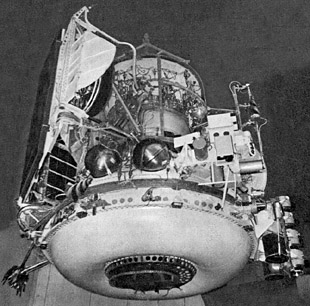 Venera-9
Venera-9
|
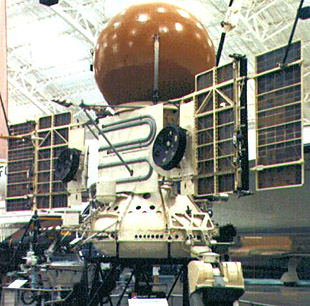 Vega
Vega
|
|
The KTDU-425 vernier engine for course corrections was located in the aft of the spacecraft, as seen above on the Venera-9 bus.
Built by Isaev's firm (KhimMash), the engine burned UDMH and nitrogen tetroxide, developing a maximum thrust of 18,890 Newtons (4300 pounds) which could be throttled down to 9856 N.
Around the engine is a pressurized toroidal compartment which housed scientific and spacecraft instrumentation.
Note solar panels folded for launch.
The spherical tanks contained nitrogen at 350 atmospheres of pressure, for the attitude-control micro motors mounted on the outer edges of the solar panels.
The cold radiator of the thermal control system can be seen on the back of the Vega bus. Like the previous Venus probes, the main cabin was pressurized, and gas was circulated through radiators to be warmed or cooled, as needed. On Venus missions, a small hot radiator was located on the sunward side, in case the craft needed to warm up. Pipes carried temperature-regulating gas to the landing module inside the reentry pod. Not included on most display models, the reentry pod had a window with thermal control shutters.
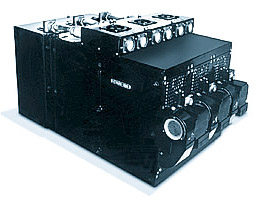 Argon-11 computer The cancelled 1967 Mars probe was the first Soviet spacecraft to carry an onboard computer: the Argon-11. Executing a carefully tuned set of 15 operations, it had 4K words of instruction ROM and 128 words of RAM and could control an onboard tape recorder. Based on medium-scale ICs and no-fail redundancy, it consumed 75 watts and weighed 34 kg. This computer first flew on the Lunar missions Zond-4 to Zond-8. M-69 used a different computer, designed by G.Ia. Guskov at a firm in Zelenograd. Lavochkin's second-generation Mars/Venus spacecraft used computers built by Piliugin's Research Institute (NII AP). The M-71 probes (Mars-2 and Mars-3) contained a modified version of their S-530 computer, designed for the N-1 manned Moon project. Far more powerful than the Argon-11, Babakin's engineers initially objected to its enormous size, consuming 800 watts and weighing 167 kilograms (about the mass of Mariner-4). These automatic control systems were quite sophisticated for their time, and were able to sight Mars and calculate mid-course corrections. Normally, course corrections would be planned by ground control, but in 1973, the Mars-6 spacecraft lost telemetry contact with Earth. It's onboard computer successfully performed its mission, including a mid-course correction and delivery of the descent vehicle. Later missions, may have used computers from Piliugin's BISER series. |
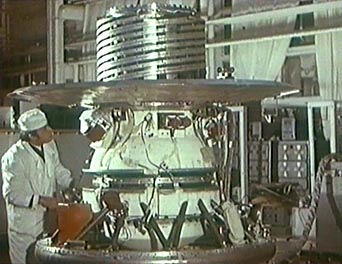 Lab Testing of Lander
Lab Testing of Lander
|
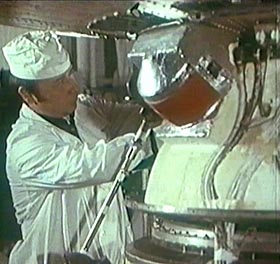 Camera Porthole
Camera Porthole
|
|
Above the pressure hull was the 2-meter aerodynamic brake, used to slow descent, and the semi-directional helical antenna. Inside the antenna were parachutes and some atmospheric sensors, not intended for long duty on the hot surface.
Note the cup anemometer on top of the aerobrake, for measuring surface winds after landing.
The vehicle landed on shock absorbers and a hollow toroidal crush pad.
The descent module included experiments for study of the clouds, atmosphere and surface:
The cameras scanned back and forth, sweeping out a 115 × 512 pixel panorama, which was digitized to 6 bits per pixel, with a 7th parity bit. A small images size (compared to Luna-9's 500 × 6000) was motivated by telemetry rates and an estimated 30-minute minimum lifetime. Two meter-band channels carried 256 bits/sec each, a conservative rate dictated by a low target error rate and the semi-directional transmitting antenna. |
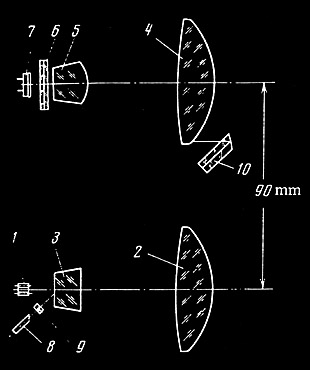 180°-degree backscatter nephelometer
180°-degree backscatter nephelometer
|
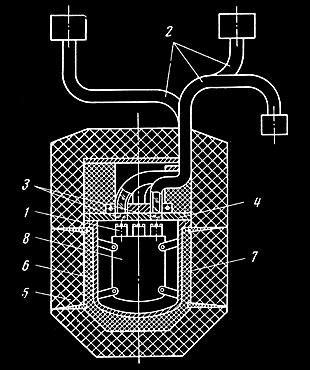 Visible and IR spectrometer
Visible and IR spectrometer
|
|
Several new experiments were designed to study the cloud layer in more detail.
M.Ia Marov's experiment measured
cloud density by
nephelometers, which sent rapidly pulsing light through a segment of atmosphere, measuring scattered reflection at angles of 4°, 15°, 45° and 180°.
From these measurements and Mie's theory of scattering, it would be possible to measure the density of droplets and some information about the their distribution of sizes.
Sensors for the nephelometer and spectrometers were outside the pressure hull, with their own insulation and phase change materials for thermal protection.
Sunlight was measured by a battery of spectrometers, at altitudes from 63 km down to the surface. The instrument diagrammed above measured light levels at green, yellow, red and two infrared wavelengths. Another instrument measured three narrow IR wavelengths corresponding to absorption bands of carbon dioxide, water vapor, and an unabsorbed reference wavelength. The spectrometer can be seen to the left of the two pipes. It was connected by fiber optics to sensors placed above and below the aerobrake.
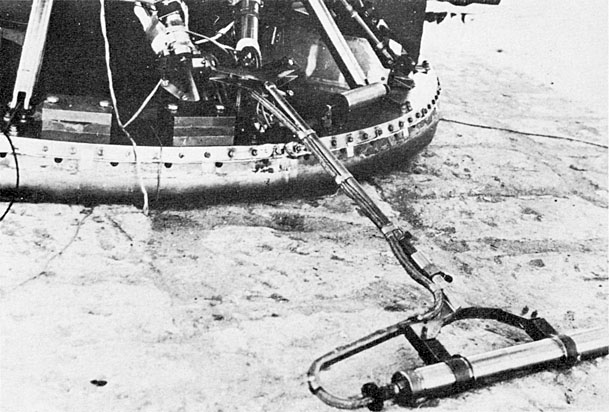
Venera-9 Gamma-Ray Densitometer A new surface experiment was a gamma-ray densitometer. Rays from a radioactive isotope would be emitted into the surface rock and the scattered reflection detected at several angles. This is the "paint-roller" shaped device seen to the right of the two pipes and in the image above. The cylindrical densitometer is 36.2 cm long and 4 cm in diameter. Three Geiger-tube detectors measure the distribution of reflected gamma rays from a radioactive cesium-137 source in the end of the densitometer. A thick lead shield between the source and the detectors blocked unscattered rays. The device was operated during the descent, measuring atmospheric-scattering, and then deployed onto the surface to measure the additional scattering due to the much denser rock. In addition, a gamma-ray spectrometer, like the one in Venera-8, was contained within the pressure hull, for the measurement of potassium, uranium and thorium abundance. This sensor consisted of a large sodium iodide crystal scintillator and a photomultiplier tube. Both the densitometer and spectrometer were built by Iu.A. Surkov's team.
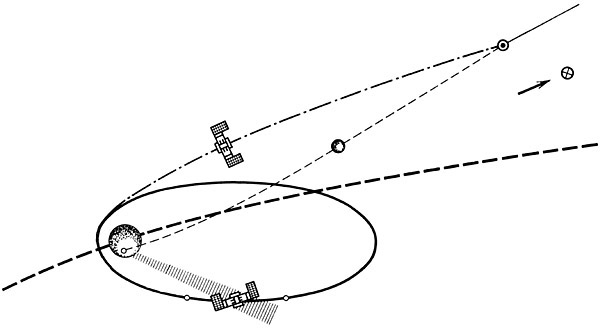 Flight plan of Venera-9 and Venera-10
Flight plan of Venera-9 and Venera-10
Venera-9 and Venera-10 were launched in 1975 on June 8 and 14. Two days before reaching Venus, the descent vehicle and the spacecraft bus separated. The descent vehicle was placed on a trajectory to enter the atmosphere, and the buses entered elliptical orbits, becoming the first artificial satellites of Venus. To transmit pictures, the lander needed radio bandwidth and light. This meant being on the sunlit side of Venus, out of radio line of sight with Earth. To solve these problems, the spacecraft bus "hovered" over the landing site, in a highly eccentric orbit, much like Earth-orbiting television satellites hovered over the Soviet Union. With a 512 bit/sec connection to the lander and a 3072 bit/sec connection to earth, the orbiter relayed data in real time and also recorded it on tape for several later playbacks. Venera-9's lander reached Venus on October 22. At an angle of 20° from the horizon, its entry was shallower than previous missions and overloads of about 170g were experienced. When deceleration forces reached a predetermined level, parachute deployment began at an altitude of about 65 kilometers. A series of pilot, drogue, braking and main parachutes slowed the vehicle in easy stages, and the two halves of the spherical reentry pod were jettisoned. The vehicle spent about 20 minutes passing through the cloud layer. Once through the clouds, there was no point in spending unnecessary time in the hot atmosphere. At an altitude of 50 kilometers, the parachutes were jettisoned, and the lander fell for 55 minutes, slowed only by the aerobrake. In the thick atmosphere, terminal velocity was 7 meters/sec at touchdown, equivalent to the impact of being dropped from 10 feet. Conditions were 90 atm pressure and 455° C (851° F). Venera-10, reached Venus three days later and carried out a similar landing. It found 91 atm of pressure and 464° C.

Image transmission from Venera-9 After landing, the gamma densitometer was deployed and, the protective camera covers were removed by pyro charges. Unfortunately, one camera cover failed to come off. The remaining camera scanned a complete 174° panorama, reversed direction, and scanned 124° of a second pass. The orbiter moved out of radio range, and the telemetry ended after 53 minutes on the surface, at which time the lander was still functioning normally. Lines of static at the beginning of the transmission are bit-stream misalignments and not actual noise. Theoretically be corrected to reveal more of the image. The periodic vertical bars of static are transmissions of telemetry from other experiments. The densitometer measured 2.88 grams/cm3. The gamma-ray spectrometer found lower levels of radiation than Venera-8. The density and potassium/uranium/thorium levels were similar to basalt. Venera-9 landed near Beta Regio, within a 150km radius of 31.01° N, 291.64° E. It landed on a steep (20°) slope covered with boulders, distinctly different from subsequent images. From high-resolution radar mapping of the region, it is suspected to be the slope of the tectonic rift valley, Aikhulu Chasma. A better view of the panorama can be seen here.
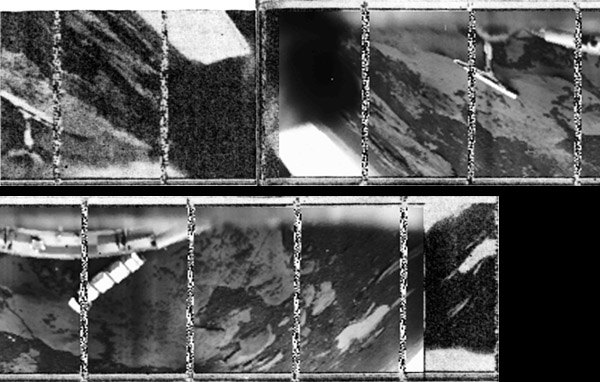
Image transmission from Venera-10 Venera-10 landed on October 25, about 2200 kilometers from Venera-9. Again, one camera cover failed to come off, but the other camera returned a 63° forward scan, 184° in the reversed scanning mode, and 17° of forward scanning. Transmission ended after 65 minutes, when the orbiter went out of radio range. Both Venera-9 and Venera-10 found the halogen lamps unnecessary. Venera-8's light readings, near the morning terminator, were much darker than the near noon-time conditions where the images were acquired. Subsequent missions did not include the lamps. Analysis of rock density and gamma spectra again indicated basalt. This time, a level flat plain of rock and soil was observed, similar to what Venera-13 would later view. The site is somewhere within a 150 km radius of 15.42° N, 291.51° E, and high resolution radar indicates a flat lava bed highly fractured by tectonic compression. A better view is here. The images above are partially composed from existing 6-bit digital image telemetry, and partially from a photocopied print of the entire data set. Hopefully better versions of the whole data set will be found, but it may be lost due to the aging of magnetic tapes.
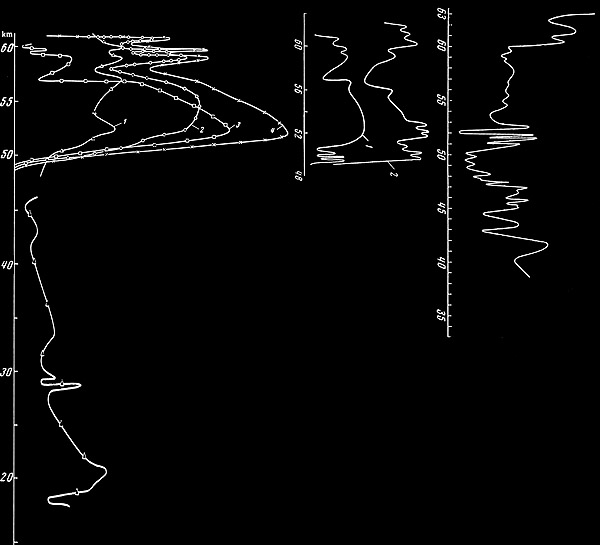
Nephelometer readings, Extinction coefficients, IR Spectrometer readings From Nephelometer results, M.Ia Marov concluded that Venus had three major cloud layers, with a bottom around 49 kilometers above the surface. Above left are the four nephelometer angular scattering measurements for Venera-9. In the center are computed optical extinction for Venera-9 (1) and the thicker clouds where Venera-10 (2) penetrated. Venera-9 and 10 found the clouds to be extremely tenuous, just a light fog with visibilities of a several kilometers. But their great depth does not allow seeing more than halfway through the upper layer. Earth-based spectral analysis of the upper surface of clouds had already shown it to be made up of very small droplets, about 1/10 the diameter of water droplets in terrestrial clouds. Marov's analysis of the multi-angle scattering indicated that the distribution of droplet sizes had two or more peaks (modes). Optical spectrometers in three visible colors and two infrared wavelengths showed an increasingly orange color to the illumination with depth. These measurements continued to the surface level, and indicated a blue-absorbing chemical may be present, in addition to the expected effects of Rayleigh scattering. Above right, the narrow-band infrared spectrometer measured light levels at a 45° angle with a very narrow field of view. Remarkably, it showed 10-fold decreases and increases of light, as the vehicle descended through regions of dense and rarefied clouds. Venera-9 and 10 carried the first mass spectrometers ever used in a planetary atmosphere, although both instruments had problems, possibly contamination by cloud material. Nitrogen and ammonia levels and the first detection of carbonyl sulphide (COS) were reported, with the caveat that the spectrometers were behaving erratically. |
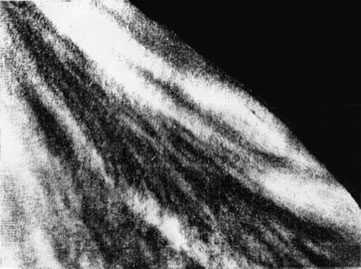 Venera-9 Orbiter Image
Venera-9 Orbiter Image
|
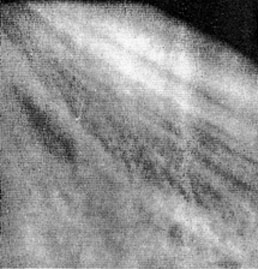 Orbiter Image
Orbiter Image
|
|
A number of experiments and observations were performed by the orbiting modules.
The two pictures above are from the same image data, unfortunately degraded by printing processes and Xerox duplication. One can only speculate about the quality of the original digital images. This data set contains unique information about the details of atmospheric dynamics on Venus, but only a few samples have been published. Several photometers and radiometers could return near and far infrared, visible and ultraviolet measurements of the clouds, along 1-dimensional slices. The photopolarimeters were filter-wheel spectrometers, the third generation of devices previously flown on Mars-3 and Mars-5. Polarimetery was introduced in the Mars-5 version, with design input from the famous French astronomer Audouin Dollfus. Polarization (or lack thereof) indicates how many times light has scattered and from how deep within the atmosphere it has been reflected. These measurements determined the altitude of the cloud layer and probed it to a sufficient depth to join up with the beginning of the descent module's data at 64 kilometers altitude. Spectrometers measured the dayside and the airglow of the night side. Flashes detected on the night side are believed caused by lightning. From photometer and camera data, Ksanfomaliti and others concluded that Venus has a colorless (even in UV) haze above the clouds. However, they concluded that the dark ultraviolet markings in the atmosphere are probably not caused by breaks in this white haze. In fact, nether "white on black" or "black on white" models fit the data, and they concluded that the dark UV absorbing material is neither above nor below the lighter cloud material. Today it is known that the bright polar collars are due to the white haze, but other UV markings are not. Mariner-5 and Mariner-10 had performed radio occultations of Venus during their fly-bys, but with two orbiters, 19 radio occultation measurements were performed in the centimeter and decimeter bands. A bistatic radar system produced 55 1-dimensional surface images, which gave information about the relief of the terrain. The data was further computer processed into several long strips of 2-dimensional relief data. |
 M.Ia. Marov
M.Ia. Marov
|
 V.I. Moroz
V.I. Moroz
|
 Iu.M. Gektin
Iu.M. Gektin
|
|
|
|
Acknowledgements: Many image are from NASA and come courtesy of their generous non-commercial usage policy. In particular, many are from the web site of David R. Williams, National Space Science Data Center, nssdc.gsfc.nasa.gov. The photograph of the Argon-11 computer is courtesy of Eduard Projdakov of the Russian Virtual Computer Museum. The color movie frame of Mars-69 is courtesy of Vladimir V. Semenov of VideoCosmos. Images of the Vega spacecraft are courtesy of Karl D. Dodenhoff. Images of the Venera-15 spacecraft are courtesy of Andy Salmon. Special thanks to Vladimir Kurt for his comments and help in finding reports and publications. |
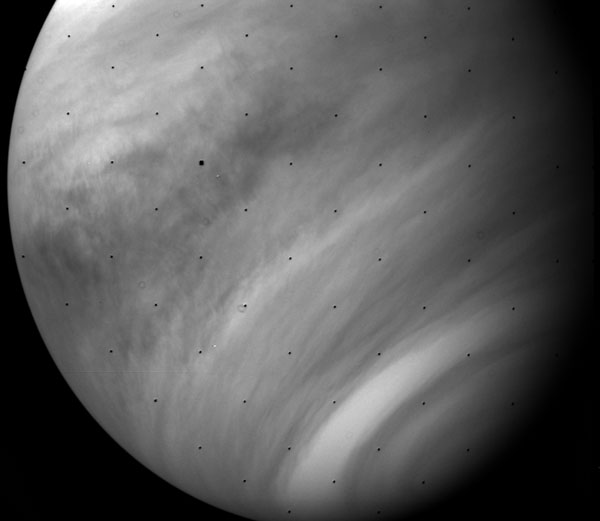
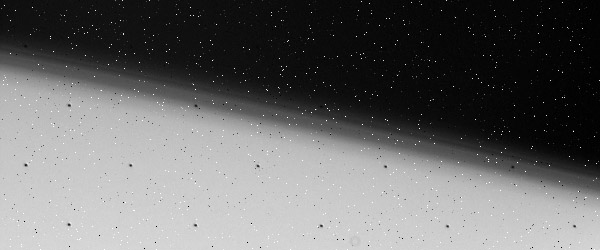
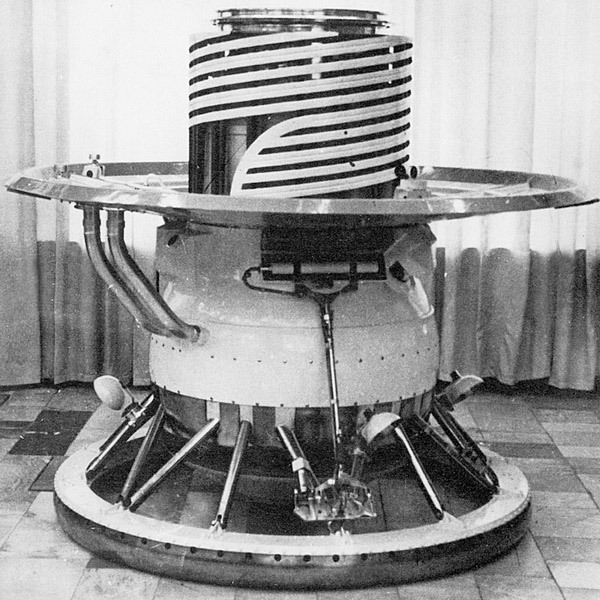 Venera-9 Lander
Venera-9 Lander
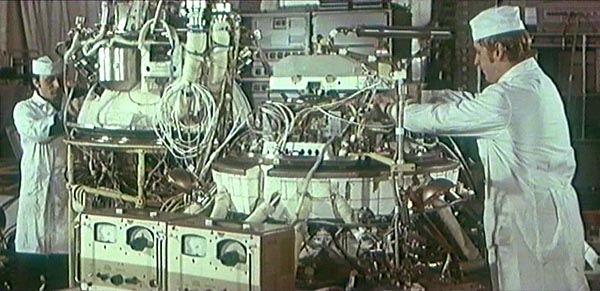 Assembly of Venera-9 Lander
Assembly of Venera-9 Lander